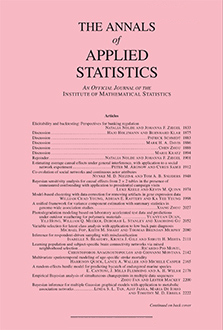Abstract
House price increases have been steady over much of the last 40 years, but there have been occasional declines, most notably in the recent housing bust that started around 2007, on the heels of the preceding housing bubble. We introduce a novel growth model that is motivated by time-warping models in functional data analysis and includes a nonmonotone time-warping component that allows the inclusion and description of boom–bust cycles and facilitates insights into the dynamics of asset bubbles. The underlying idea is to model longitudinal growth trajectories for house prices and other phenomena, where temporal setbacks and deflation may be encountered, by decomposing such trajectories into two components. A first component corresponds to underlying steady growth driven by inflation that anchors the observed trajectories on a simple first order linear differential equation, while a second boom–bust component is implemented as time warping. Time warping is a commonly encountered phenomenon and reflects random variation along the time axis. Our approach to time warping is more general than previous approaches by admitting the inclusion of nonmonotone warping functions. The anchoring of the trajectories on an underlying linear dynamic system also makes the time-warping component identifiable and enables straightforward estimation procedures for all model components. The application to the dynamics of housing prices as observed for 19 metropolitan areas in the U.S. from December 1998 to July 2013 reveals that the time setbacks corresponding to nonmonotone time warping vary substantially across markets and we find indications that they are related to market-specific growth rates.
Citation
Jie Peng. Debashis Paul. Hans-Georg Müller. "Time-warped growth processes, with applications to the modeling of boom–bust cycles in house prices." Ann. Appl. Stat. 8 (3) 1561 - 1582, September 2014. https://doi.org/10.1214/14-AOAS740
Information





